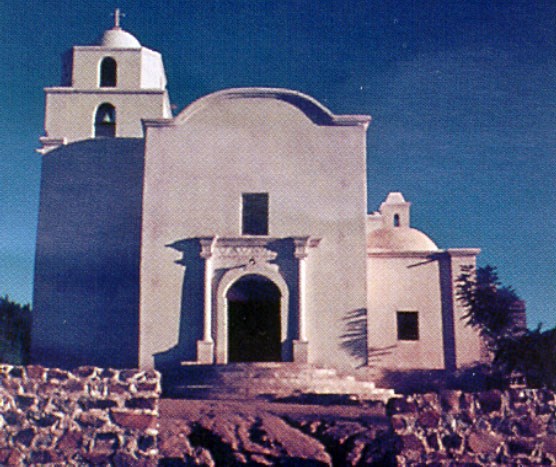
San Diego del Pitiquito was founded in 1694 by Father Kino who frequently visited the village of Pitiqui. Since there were two villages in Sonora named Pitiqui, or “Pitic” (the other being larger and located at the site of the present-day city of Hermosillo), this village became known as Pitiquito, or “Little Pitic.” It remained a visita of Caborca throughout the Jesuit and into the Franciscan period until 1778. The first church was under construction in 1706 but was gone by 1730. The next church appeared in 1760 shortly after the Pima uprising. Apparently not much happened over the next 38 years because Father Juan Marcelo Diaz, who was stationed at Caborca, remarked in 1768 that “it was so poorly furnished and that he had to take everything with him in order to celebrate Mass.” Bishop Antonio de los Reyes on 6 July 1772 wrote a report on the condition of the missions in the Upper and Lower Pimería. Following is his report on San Diego del Pitiquito as translated by Father Kieran McCarty:
"This situation was remedied beginning in the late 1770s when Father José Matías Moreno started to raise the lime-mortared brick church whose remodeled form one sees at Pitiquito today. Moreno was baptizing Indians at Pitiquito by March of 1776, and he probably started construction then or very soon afterward. It was his successor, Father Pedro Font, who was baptizing people at Pitiquito by January of 1780, who brought the building to its initial state of completion before his death a little less than two years later.” "It appears that many additions and alterations have been made at Pitiquito, both inside and out since 1781. Records describing these have yet to come to light." (The Pimeria Alta: Southwestern Mission Research Center) In 1966, a small girl, bored with the proceedings of the Mass, looked up at the south wall at the rear of the nave and noticed a huge skeleton painted there. She pointed it out to her mother who screamed when she saw it. Beneath it, the words MANE THECEL PHARES appeared. From the book of Daniel (5:25-28) this is interpreted to mean that King Belshazzar had been found wanting and God was about to divide up his kingdom and give it to the Medes and Persians. The parishioners thought the world was coming to an end. Later investigations revealed that numerous paintings had been whitewashed over long before the memory of any living person. Cleaning ladies had uncovered them when the chemicals from strong detergents interacted with the lime plaster to show the art. Since then, many other pictures have been uncovered by conservation experts. Beneath the level of the aforementioned paintings, remnants of picture frames date from the time the church was first completed and probably depicted the Stations of the Cross. They are on the original layer of plaster and were concealed under other coats of plaster and white wash. These reflect the work of an O'odham artisan. One of the picture frames has serpents forming the sides with the upper side capped with triangles and heads of figures wearing ceremonial headdresses. |
Last updated: May 6, 2025
